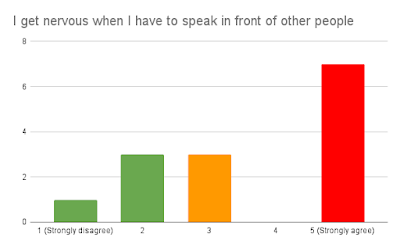Through researching the topic, I found an article which discussed the process of using public speaking and oral presentations in the classroom.
Boyce, Alber-Morgan, Riley (20067). Fearless Public Speaking: Oral Presentation Activities for the Elementary Classroom.
Through communications with Naomi Rosedale from the Research team at Manaiakalani, I was reassured that Public Speaking was the correct avenue to be looking down for my inquiry however, I needed a bit more direction as this is still quite a vast topic.
Naomi also suggested I look into read aloud - in particular vocal modulation and prosody. She also suggested I look into 'journalism.'
With a focus on confidence, Naomi suggested I need some baseline data of speaking (by getting the children reading aloud or speaking) as well as confidence (self-efficacy). I have already had children fill out a questionnaire/survey for confidence/self-efficacy however I haven't yet got any baseline data of speaking. This is therefore my next step. I will need to formulate a rubric for speaking which includes such things as delivery, content and audience awareness.
Something I should be aware of (which my attention was drawn to during communicaitons with Naomi) is whether my focus is on scripted or un-scripted oral language. These are quite different things. In terms of the children I am focussing on, I think my focus for this year will be on scripted oral-language as I want my focus to be on developing confidence for these children. The children who I would like to work with are not my general news crew, but a group of children with which we want to develop confidence.





.png)
.png)












